
|
Now it is bright as 8.4 mag (Oct. 23, Marco Goiato). It is observable at 8 mag for a long time from 2022 to 2023. In the Southern Hemisphere, it stays observable for a long time, although it becomes low temporarily from November to December. In the Northern Hemisphere, it is not observable until 2023 summer.
Date(TT) R.A. (2000) Decl. Delta r Elong. m1 Best Time(A, h)
Nov. 5 16 25.91 -44 5.3 2.589 1.886 36 8.1 18:28 ( 45,-14)
Nov. 12 16 35.05 -46 27.3 2.595 1.861 34 8.1 18:23 ( 45,-18)
|
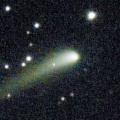
|
Now it is bright as 11.0 mag (Nov. 3, Osamu Miyazaki). It will approach to Earth down to 0.29 a.u. in 2023 February, and it is expected to brighten up to 5 mag. In the Northern Hemisphere, it stays observable in excellent condition for a long time, although it becomes extremely low temporarily in November. In the Southern Hemisphere, it is not observable until early February.
Date(TT) R.A. (2000) Decl. Delta r Elong. m1 Best Time(A, h)
Nov. 5 15 49.65 24 37.8 2.112 1.554 43 10.5 18:28 (108, 18)
Nov. 12 15 50.03 24 25.3 2.039 1.482 43 10.3 18:23 (110, 14)
|
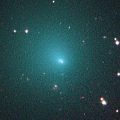
|
Now it is very bright as 9.7 mag (Oct. 23, Marco Goiato). It stays 10 mag until November. In the Northern Hemisphere, it becomes unobservable soon. In the Southern Hemisphere, it becomes unobservable temporarily from December to January.
Date(TT) R.A. (2000) Decl. Delta r Elong. m1 Best Time(A, h)
Nov. 5 20 8.18 -41 32.5 1.587 1.624 74 10.3 18:28 ( 15, 11)
Nov. 12 19 54.60 -40 53.7 1.754 1.609 65 10.4 18:23 ( 22, 10)
|
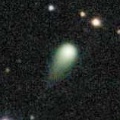
|
Now it is 11.6 mag (Nov. 2, Osamu Miyazaki). It is expected to brighten up to 10 mag in 2023. In the Northern Hemisphere, it stays observable in good condition until 2023 autumn. In the Southern Hemipshere, it stays unobservable until 2023 summer.
Date(TT) R.A. (2000) Decl. Delta r Elong. m1 Best Time(A, h)
Nov. 5 11 8.79 61 52.8 2.910 3.037 87 11.1 4:58 (213, 50)
Nov. 12 11 11.69 64 26.5 2.760 2.987 93 11.0 5:04 (207, 52)
|

|
It brightened up to 8.3 mag in last winter (Jan. 6, Toshiyuki Takahashi). Now it is fading. But it is bright as 11.5 mag still now (Oct. 30, Osamu Miyazaki).
Date(TT) R.A. (2000) Decl. Delta r Elong. m1 Best Time(A, h)
Nov. 5 9 53.30 -19 0.5 4.727 4.449 67 11.6 4:58 (327, 29)
Nov. 12 9 56.05 -20 33.3 4.676 4.486 72 11.6 5:04 (336, 31)
|
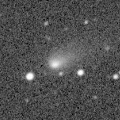
|
Now it is 11.4 mag (Oct. 29, Osamu Miyazaki). Appearing in the morning sky also in the Southern Hemisphere. It stays 11-12 mag until spring.
Date(TT) R.A. (2000) Decl. Delta r Elong. m1 Best Time(A, h)
Nov. 5 11 54.93 1 20.6 2.212 1.648 43 11.8 4:58 (287, 25)
Nov. 12 12 14.01 -0 32.1 2.160 1.633 45 11.7 5:04 (291, 26)
|
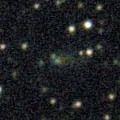
|
Now it is 12.1 mag (Oct. 28, Thomas Lehmann). It stays bright as 11-12 mag until January, and it is observable in excellent condition.
Date(TT) R.A. (2000) Decl. Delta r Elong. m1 Best Time(A, h)
Nov. 5 8 0.63 9 12.5 1.358 1.836 101 12.0 4:58 (356, 64)
Nov. 12 8 10.98 8 38.0 1.294 1.832 105 11.8 4:48 ( 0, 64)
|

|
Now it is 13.8 mag (Oct. 15, Chris Wyatt). It is expected to brighten up to 11 mag in 2023. In the Northern Hemisphere, it will be unobservable in November. In the Southern Hemisphere, it stays observable in good condition for a long time, although it becomes unobservable temporarily from November to January.
Date(TT) R.A. (2000) Decl. Delta r Elong. m1 Best Time(A, h)
Nov. 5 17 33.49 -15 27.8 4.233 3.558 41 12.3 18:28 ( 58, 15)
Nov. 12 17 38.49 -16 47.2 4.276 3.525 36 12.3 18:23 ( 60, 11)
|
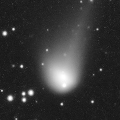
|
Now it is bright as 12.8 mag (Aug. 28, Hiroshi Abe). It stays 12 mag for a while. It becomes unobservable from August to November in the Northern Hemisphere, or from September to December in the Southern Hemisphere.
Date(TT) R.A. (2000) Decl. Delta r Elong. m1 Best Time(A, h)
Nov. 5 14 8.77 -3 1.0 5.372 4.419 14 12.8 4:58 (270, -5)
Nov. 12 14 16.41 -2 55.6 5.358 4.435 19 12.8 5:04 (274, 0)
|

|
Now it is 14.7 mag (Oct. 26, Michael Jager). It is expected to brighten up to 12 mag from winter to summer in 2023. In the Northern Hemisphere, it stays observable in good condition until 2023 spring. In the Southern Hemisphere, it stays observable in good condition for a long time after this. It is fainter than this ephemeris recently.
Date(TT) R.A. (2000) Decl. Delta r Elong. m1 Best Time(A, h)
Nov. 5 4 57.18 23 0.8 2.012 2.892 146 13.1 2:03 ( 0, 78)
Nov. 12 4 48.42 20 18.8 1.905 2.838 155 12.9 1:27 ( 0, 75)
|
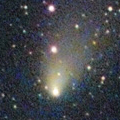
|
It brightened up to 10.4 mag from June to July (July 22, Ken-ichi Kadota). Appearing in the morning sky in the Souther Hemisphere. It will never be observable again in the Northern Hemisphere.
Date(TT) R.A. (2000) Decl. Delta r Elong. m1 Best Time(A, h)
Nov. 5 14 5.77 -51 27.2 2.562 1.862 36 12.9 4:58 (315,-28)
Nov. 12 14 31.12 -54 21.4 2.632 1.942 37 13.2 5:04 (319,-28)
|
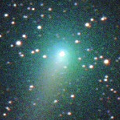
|
It brightened up to 9.3 mag in early summer (June 5, Chris Wyatt). Now it is fading. It has already faded down to 14.6 mag (Oct. 29, Chris Wyatt). In the Southen Hemisphere, it stays observable in good condition for a long time. In the Northern Hemisphere, it will be observable after November.
Date(TT) R.A. (2000) Decl. Delta r Elong. m1 Best Time(A, h)
Nov. 5 10 7.13 -41 41.6 2.826 2.542 63 13.2 4:58 (336, 7)
Nov. 12 10 2.13 -42 18.3 2.800 2.602 68 13.3 5:04 (342, 10)
|
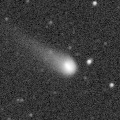
|
Now it is 13.7 mag (Sept. 24, Hiroshi Abe). It is expected to brighten up to 12 mag in 2023. In the Northern Hemisphere, it stays observable in good condition for a long time, although it becomes unobservable temporarily in October. In the Southern Hemisphere, it is not observable until mid December. But it will be observable in good condition in 2023.
Date(TT) R.A. (2000) Decl. Delta r Elong. m1 Best Time(A, h)
Nov. 5 13 43.85 10 26.7 4.685 3.851 29 13.3 4:58 (263, 8)
Nov. 12 13 46.04 9 27.0 4.616 3.831 33 13.2 5:04 (268, 14)
|

|
Now it is 13.6 mag (Oct. 23. Toshihiko Ikemura, Hirohisa Sato).
Date(TT) R.A. (2000) Decl. Delta r Elong. m1 Best Time(A, h)
Nov. 5 6 58.95 29 7.1 5.495 6.040 119 13.6 4:04 ( 0, 84)
Nov. 12 6 58.03 29 11.0 5.403 6.042 126 13.5 3:35 ( 0, 84)
|
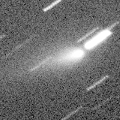
|
Outburst occured in early October. Now it is very bright as 10.4 mag (Oct. 15, Chris Wyatt). It stays observable in good condition in the Southern Hemisphere. It locates low in the Northern Hemisphere. Michael Jager detected several fragments at 17.5-19 mag.
Date(TT) R.A. (2000) Decl. Delta r Elong. m1 Best Time(A, h)
Nov. 5 20 10.96 -32 55.5 1.229 1.377 75 14.0 18:28 ( 16, 20)
Nov. 12 20 42.19 -30 52.1 1.314 1.440 75 14.5 18:23 ( 15, 23)
|
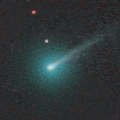
|
It brightened rapidly up to 12.4 mag in early October (Oct. 2, Michael Jager). Then it became fainter a bit, 13.3 mag (Oct. 26, Ken-ichi Kadota). Although it is a tiny comet, it approached to Sun down to 0.63 a.u. on Oct. 25. It is not observable after this.
Date(TT) R.A. (2000) Decl. Delta r Elong. m1 Best Time(A, h)
Nov. 5 14 17.08 8 37.7 1.431 0.674 24 14.1 4:58 (260, 0)
Nov. 12 14 45.94 3 21.9 1.562 0.737 21 14.6 5:04 (265, -2)
|
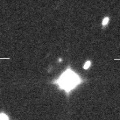
|
Now it is 14.3 mag (Oct. 15, Ken-ichi Kadota). It is expected to brighten up to 12.5 mag in winter. In the Northern Hemisphere, it will be observable in good condition after this. In the Southern Hemisphere, it is not observable until 2023 June.
Date(TT) R.A. (2000) Decl. Delta r Elong. m1 Best Time(A, h)
Nov. 5 12 44.10 22 43.0 2.740 2.195 47 14.6 4:58 (260, 27)
Nov. 12 12 56.76 24 26.6 2.594 2.144 52 14.4 5:04 (261, 32)
|

|
Now it is 14.7 mag (Oct. 14, Chris Wyatt). It stays observable at 13-14 mag for a while.
Date(TT) R.A. (2000) Decl. Delta r Elong. m1 Best Time(A, h)
Nov. 5 19 27.05 -29 27.4 3.348 3.097 66 14.5 18:28 ( 27, 20)
Nov. 12 19 36.78 -29 0.2 3.440 3.104 62 14.5 18:23 ( 30, 19)
|
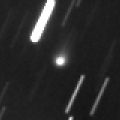
|
Now it is 14.5 mag (Oct. 29, Chris Wyatt). It stays 14 mag in 2023. In the Southern Hemisphere, it stays observable in good condition for a long time. It locates somewhat low in the Northern Hemisphere.
Date(TT) R.A. (2000) Decl. Delta r Elong. m1 Best Time(A, h)
Nov. 5 5 54.26 -21 52.1 3.174 3.761 119 14.8 2:59 ( 0, 33)
Nov. 12 5 41.06 -22 51.2 3.073 3.728 124 14.7 2:19 ( 0, 32)
|
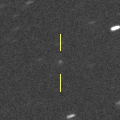
|
It will brighten up to 13 mag in winter. But the condition is bad. It is not observable until February in the Southern Hemisphere, or until May in the Northern Hemisphere.
Date(TT) R.A. (2000) Decl. Delta r Elong. m1 Best Time(A, h)
Nov. 5 14 46.49 -14 24.6 2.744 1.754 2 14.9 18:28 ( 83,-16)
Nov. 12 15 4.95 -16 7.3 2.717 1.727 1 14.7 5:04 (278,-17)
|

|
Now it is 15.1 mag (Oct. 26, Thomas Lehmann). The brightness evolution is slower than originally expected. It stays 14-15 mag for a long time. It locates extremely low in the Northern Hemisphere. In the Southern Hemisphere, it will be unobservable temporarily in November.
Date(TT) R.A. (2000) Decl. Delta r Elong. m1 Best Time(A, h)
Nov. 5 17 3.37 -21 49.0 3.760 2.997 34 14.7 18:28 ( 58, 6)
Nov. 12 17 8.10 -20 36.6 3.841 3.010 28 14.8 18:23 ( 62, 3)
|
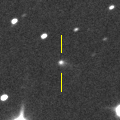
|
Now it is 15.6 mag (Oct. 19, Ken-ichi Kadota). It will brighten up to 14 mag in early 2023, and it will be observable in good condition. It is fainter than this ephemeris recently.
Date(TT) R.A. (2000) Decl. Delta r Elong. m1 Best Time(A, h)
Nov. 5 9 5.92 16 32.7 3.375 3.488 88 14.9 4:58 (314, 65)
Nov. 12 9 12.20 16 39.6 3.262 3.472 93 14.8 5:04 (328, 69)
|

|
The condition is worst in this apparition. It is not observable at all.
Date(TT) R.A. (2000) Decl. Delta r Elong. m1 Best Time(A, h)
Nov. 5 16 4.85 -15 52.7 2.140 1.261 20 15.0 18:28 ( 71, -1)
Nov. 12 16 31.59 -17 11.5 2.196 1.312 20 15.6 18:23 ( 70, -1)
|
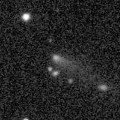
|
Now it is 14.8 mag (Oct. 25, Michael Jager). It stays 15 mag and observable in excellent condition until December.
Date(TT) R.A. (2000) Decl. Delta r Elong. m1 Best Time(A, h)
Nov. 5 2 22.73 22 14.4 1.434 2.420 172 15.1 23:24 ( 0, 77)
Nov. 12 2 16.15 23 7.9 1.448 2.423 166 15.1 22:50 ( 0, 78)
|
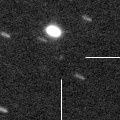
|
Now it is 15.3 mag (Oct. 29, Chris Wyatt). It is expected to brighten up to 8 mag in 2023 July. In 2022, it stays observable in good condition while the comet will be brightening gradually.
Date(TT) R.A. (2000) Decl. Delta r Elong. m1 Best Time(A, h)
Nov. 5 2 5.42 -7 54.0 2.743 3.666 155 15.3 23:06 ( 0, 47)
Nov. 12 1 51.66 -9 16.2 2.724 3.597 147 15.2 22:25 ( 0, 46)
|
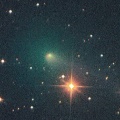
|
Now it is 14.8 mag (Oct. 20, Toshihiko Ikemura, Hirohisa Sato). It stays observable in good condition after this. But it will be fading gradually after this.
Date(TT) R.A. (2000) Decl. Delta r Elong. m1 Best Time(A, h)
Nov. 5 0 51.12 -2 15.8 1.722 2.616 147 15.2 21:53 ( 0, 53)
Nov. 12 0 48.34 -2 17.4 1.819 2.658 140 15.5 21:22 ( 0, 53)
|
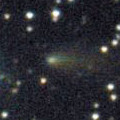
|
Now it is 15.0 mag (Oct. 26, Toshihiko Ikemura, Hirohisa Sato). It stays observable in good condition at 15 mag from summer to winter. It locates somwwhat low in the Southern Hemisphere.
Date(TT) R.A. (2000) Decl. Delta r Elong. m1 Best Time(A, h)
Nov. 5 7 56.75 19 0.6 1.949 2.402 104 15.3 4:58 (357, 74)
Nov. 12 8 1.77 19 3.2 1.881 2.414 110 15.3 4:39 ( 0, 74)
|
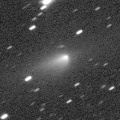
|
It brightened up to 12.7 mag in early 2022 (Feb. 27, Toshihiko Ikemura, Hirohisa Sato). Now it is fading. Now it is not observable. It will be observable agin at 16 mag in January in the Southern Hemisphere, or in February in the Northern Hemisphere.
Date(TT) R.A. (2000) Decl. Delta r Elong. m1 Best Time(A, h)
Nov. 5 15 5.15 -18 45.7 3.310 2.329 7 15.3 18:28 ( 77,-15)
Nov. 12 15 19.92 -19 48.4 3.332 2.345 3 15.4 18:23 ( 77,-17)
|

|
Now it is 14.8 mag (Oct. 29, Chris Wyatt). It was expected to brighten up to 13 mag in spring. But actually, it was fainter than originally expected. In the Southern Hemisphere, it stays observable in good condition for a long time. In the Northern Hemisphere, it stays extremely low for a while.
Date(TT) R.A. (2000) Decl. Delta r Elong. m1 Best Time(A, h)
Nov. 5 4 54.50 -53 46.8 3.019 3.412 104 15.3 2:00 ( 0, 1)
Nov. 12 4 31.73 -53 40.0 3.023 3.438 106 15.3 1:10 ( 0, 1)
|
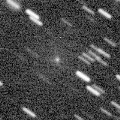
|
Now it is 16.1 mag (Nov. 2, Michael Jager). It brightens up to 13 mag in January. In the Northern Hemisphere, it stays observable in excellent condition. In the Southern Hemisphere, it is not observable until February.
Date(TT) R.A. (2000) Decl. Delta r Elong. m1 Best Time(A, h)
Nov. 5 19 0.79 68 12.9 1.252 1.673 95 15.7 18:28 (159, 51)
Nov. 12 18 54.85 67 37.7 1.199 1.615 94 15.5 18:23 (156, 49)
|
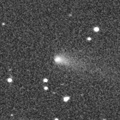
|
Now it is 14.8 mag (Oct. 25, Michael Jager). It stays 15 mag until November, and it stays observable in good condition.
Date(TT) R.A. (2000) Decl. Delta r Elong. m1 Best Time(A, h)
Nov. 5 1 18.38 -0 6.6 1.189 2.128 154 15.7 22:20 ( 0, 55)
Nov. 12 1 16.73 -0 22.1 1.229 2.131 147 15.7 21:51 ( 0, 55)
|
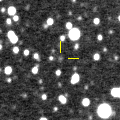
|
Now it is 16.1 mag (Oct. 23, G. Duszanowicz, J. Camarasa). It will brighten up to 13 mag from 2024 to 2025.
Date(TT) R.A. (2000) Decl. Delta r Elong. m1 Best Time(A, h)
Nov. 5 9 9.18 -32 46.9 7.252 7.069 75 15.8 4:58 (343, 20)
Nov. 12 9 11.26 -33 34.8 7.146 7.035 79 15.8 5:04 (350, 21)
|
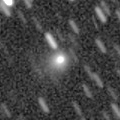
|
It brightened by 6 mag in outburst in early August up to 14.6 mag (Aug. 13, ATLAS-MLO, Mauna Loa). It is bright as 15.9 mag still now (Oct. 25, Michael Jager). It seems to stay 16 mag for a while. It stays observable in good condition for a while.
Date(TT) R.A. (2000) Decl. Delta r Elong. m1 Best Time(A, h)
Nov. 5 19 48.68 -5 32.3 1.819 1.855 76 16.0 18:28 ( 34, 44)
Nov. 12 20 3.94 -6 30.1 1.856 1.830 72 16.0 18:23 ( 36, 42)
|
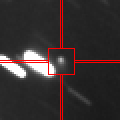
|
Now it is 15.7 mag (Oct. 25, Toshihiko Ikemura, Hirohisa Sato). It is expected to brighten up to 7 mag in early 2024. In the Southern Hemisphere, it stays observable in good condition for a long time. In the Northern Hemisphere, it stays low in 2022.
Date(TT) R.A. (2000) Decl. Delta r Elong. m1 Best Time(A, h)
Nov. 5 6 18.53 -32 58.1 5.200 5.597 108 16.1 3:23 ( 0, 22)
Nov. 12 6 16.23 -34 2.1 5.092 5.534 111 16.0 2:53 ( 0, 21)
|
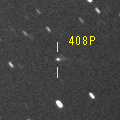
|
Now it is 16.4 mag (Nov. 2, Catalina Sky Survey). It will be observable at 16-17 mag in excellent condition from autumn to winter.
Date(TT) R.A. (2000) Decl. Delta r Elong. m1 Best Time(A, h)
Nov. 5 4 32.57 1 13.5 2.586 3.471 148 16.1 1:38 ( 0, 56)
Nov. 12 4 29.14 0 28.7 2.558 3.472 153 16.1 1:07 ( 0, 56)
|
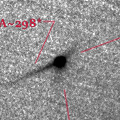
|
Due to the DART spacecraft impact to its satellite Dimorphos on Sept. 26, the cometary activity was detected. It brightened up to 12.9 mag (Sept. 28, John Drummond). It is fading after that. It has already faded down to 15.9 mag (Oct. 29, Katsumi Yoshimoto). It stays observable in good condition for a while.
Date(TT) R.A. (2000) Decl. Delta r Elong. m1 Best Time(A, h)
Nov. 5 7 56.49 8 20.3 0.119 1.024 102 16.2 4:58 (359, 63)
Nov. 12 8 10.40 12 18.2 0.134 1.037 107 16.3 4:47 ( 0, 67)
|
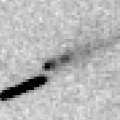
|
It brightened up to 16.1 mag in autumn (Sept. 23, Michael Jager). Then it is fading very rapidly. It has already faded down to 17.9 mag (Oct. 28, Ken-ichi Kadota). It will be getting higher after this also in the Southern Hemisphere.
Date(TT) R.A. (2000) Decl. Delta r Elong. m1 Best Time(A, h)
Nov. 5 10 7.10 9 37.4 1.689 1.672 71 16.4 4:58 (302, 50)
Nov. 12 10 20.01 7 27.2 1.655 1.697 75 16.4 5:04 (310, 52)
|
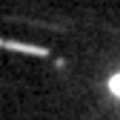
|
It will brighten rapidly up to 14 mag in spring. In the Southern Hemisphere, it will appear in the morning sky in December, and it will be observable in excellent condition in spring. In the Northern Hemisphere, it is observable in good condition in winter, but it becomes somewhat low in spring.
Date(TT) R.A. (2000) Decl. Delta r Elong. m1 Best Time(A, h)
Nov. 5 12 25.84 6 50.7 3.222 2.542 39 16.7 4:58 (277, 22)
Nov. 12 12 36.39 5 15.0 3.148 2.526 43 16.5 5:04 (282, 26)
|
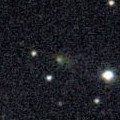
|
Now it is 16.7 mag (Oct. 27, Katsumi Yoshimoto). It will be observable at 16-17 mag in good condition from summer to autumn.
Date(TT) R.A. (2000) Decl. Delta r Elong. m1 Best Time(A, h)
Nov. 5 3 22.84 26 43.9 1.592 2.562 164 16.7 0:29 ( 0, 82)
Nov. 12 3 16.69 26 11.7 1.607 2.589 171 16.8 23:50 ( 0, 81)
|
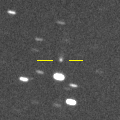
|
Now it is 17.7 mag (July 9, ATLAS Chile). It will brighten up to 16 mag in 2023. In the Southern Hemisphere, it stays observable in good condition for a long time, although it became low temporarily from August to October. In the Northern Hemisphere, it will never be observable again.
Date(TT) R.A. (2000) Decl. Delta r Elong. m1 Best Time(A, h)
Nov. 5 12 33.30 -43 47.8 4.087 3.374 38 16.8 4:58 (316,-11)
Nov. 12 12 45.50 -45 47.8 4.043 3.356 40 16.8 5:04 (320,-10)
|

|
It brightened up to 14 mag in 2021. Now it is fading. It has already faded down to 16.6 mag (Oct. 26, Thomas Lehmann). It is observable at 16-17 mag in 2022.
Date(TT) R.A. (2000) Decl. Delta r Elong. m1 Best Time(A, h)
Nov. 5 23 19.82 15 3.4 5.681 6.388 132 16.8 20:22 ( 0, 70)
Nov. 12 23 18.08 15 1.2 5.805 6.426 125 16.9 19:52 ( 0, 70)
|
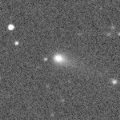
|
Now it is 16.5 mag (Oct. 22, ATLAS-MLO, Mauna Loa). It continued brightening even after the perihelion passage. It stays observable at 16 mag in good condition for a while.
Date(TT) R.A. (2000) Decl. Delta r Elong. m1 Best Time(A, h)
Nov. 5 22 56.89 -3 38.4 3.765 4.369 121 16.8 19:59 ( 0, 51)
Nov. 12 22 57.62 -3 40.8 3.872 4.382 114 16.9 19:32 ( 0, 51)
|
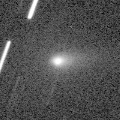
|
It brightened rapidly as predicted, and it brightened up to 14.0 mag in September (Sept. 22, Michael Jager). Now it is fading. It has already faded down to 16.4 mag (Nov. 3, ATLAS Chile). It will be fainter than 18 mag in December.
Date(TT) R.A. (2000) Decl. Delta r Elong. m1 Best Time(A, h)
Nov. 5 2 15.41 -39 12.4 0.909 1.686 125 16.8 23:17 ( 0, 16)
Nov. 12 2 14.98 -39 55.6 0.977 1.714 121 17.1 22:49 ( 0, 15)
|
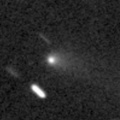
|
Now it is 16.0 mag (Oct. 19, Toshihiko Ikemura, Hirohisa Sato). Now it is fading. It stays 13-14 mag for a while. It is observable in excellent condition in the Southern Hemisphere. It locates somewhat low in the Northern Hemisphere.
Date(TT) R.A. (2000) Decl. Delta r Elong. m1 Best Time(A, h)
Nov. 5 22 24.23 -23 22.3 2.159 2.620 106 16.9 19:27 ( 0, 32)
Nov. 12 22 28.56 -22 19.8 2.285 2.659 101 17.2 19:04 ( 0, 33)
|

|
Now it is 15.8 mag (Oct. 19, Toshihiko Ikemura, Hirohisa Sato). It brightened up to 14 mag from 2020 to 2021. Now it is fading slowly. It is observable at 16-17 mag in 2022.
Date(TT) R.A. (2000) Decl. Delta r Elong. m1 Best Time(A, h)
Nov. 5 0 7.48 -19 38.3 3.369 4.064 128 17.0 21:09 ( 0, 36)
Nov. 12 0 5.61 -19 14.7 3.467 4.081 122 17.1 20:40 ( 0, 36)
|
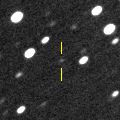
|
Now it is 17.3 mag (Oct. 30, ATLAS Chile). It is expected to brighten up to 12-13 mag from 2024 to 2025.
Date(TT) R.A. (2000) Decl. Delta r Elong. m1 Best Time(A, h)
Nov. 5 10 33.76 -19 2.2 7.227 6.761 58 17.1 4:58 (318, 24)
Nov. 12 10 34.33 -19 16.1 7.086 6.716 64 17.0 5:04 (326, 28)
|

|
It brightened very rapidly up to 15.5 mag from last autumn to last winter (Nov. 2, 2021, Toshihiko Ikemura, Hirohisa Sato). Now it is fading slowly. It has already faded down to 16.5 mag (Oct. 25, Toshihiko Ikemura, Hirohisa Sato).
Date(TT) R.A. (2000) Decl. Delta r Elong. m1 Best Time(A, h)
Nov. 5 6 49.50 11 26.9 3.749 4.320 119 17.1 3:54 ( 0, 66)
Nov. 12 6 48.85 11 2.8 3.681 4.339 126 17.1 3:26 ( 0, 66)
|

|
Now it is 16.7 mag (Oct. 29, ATLAS-MLO, Mauna Loa). Fading slowly. In the Northern Hemisphere, it stays observable in good condition for a long time. In the Southern Hemisphere, it is not observable after this.
Date(TT) R.A. (2000) Decl. Delta r Elong. m1 Best Time(A, h)
Nov. 5 17 18.76 62 57.4 9.533 9.488 84 17.1 18:28 (146, 43)
Nov. 12 17 22.29 62 47.9 9.545 9.502 84 17.2 18:23 (146, 41)
|
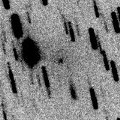
|
Now it is 17.6 mag (Oct. 25, Michael Jager). Tiny comet, but it will approach to Sun down to 0.8 a.u. in January, and to Earth down to 0.6 a.u. in March. It will brighten up to 14 mag from January to March. In the Southern Hemisphere, it stays observable in good condition for a long time. In the Northern Hemisphere, it is observable only until early Decemebr. Then it will become observable again in early March.
Date(TT) R.A. (2000) Decl. Delta r Elong. m1 Best Time(A, h)
Nov. 5 20 9.76 -21 14.2 1.472 1.591 77 17.4 18:28 ( 21, 31)
Nov. 12 20 11.57 -24 48.1 1.504 1.498 70 17.1 18:23 ( 24, 26)
|

|
It brightened up to 14.2 mag in 2021 summer (July 18, 2021, Taras Prystavski). Now it is fading. It has already faded down to 16.5 mag (Oct. 19, Hirohisa Sato). In the Southern Hemisphere, it stays observable in good condition for a long time. It locates somewhat low in the Northern Hemisphere.
Date(TT) R.A. (2000) Decl. Delta r Elong. m1 Best Time(A, h)
Nov. 5 1 32.23 -25 38.6 4.877 5.630 135 17.2 22:33 ( 0, 30)
Nov. 12 1 27.92 -25 3.1 4.974 5.673 131 17.2 22:02 ( 0, 30)
|
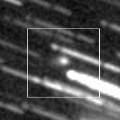
|
Now it is 16.8 mag (Oct. 20, Ken-ichi Kadota). It is expected to brighten up to 11-12 mag in 2024. In the Northern Hemisphere, it stays observable in good condition for a long time until 2023 autumn, although it becomes temporarily low in December. In the Southern Hemisphere, it is not observable until February. But it will be observable in excellent condition at the high light.
Date(TT) R.A. (2000) Decl. Delta r Elong. m1 Best Time(A, h)
Nov. 5 17 57.44 19 10.6 5.886 5.455 59 17.2 18:28 ( 85, 42)
Nov. 12 17 58.99 18 20.8 5.903 5.403 55 17.2 18:23 ( 87, 37)
|
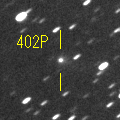
|
It brightened up to 15.3 mag in last winter (Jan. 12, H. Nohara). Now it is fading. It has already faded down to 17.5 mag (Nov. 1, ATLAS-MLO, Mauna Loa). It will be observable at 17 mag in good condition in next winter. It locates low in the Southern Hemisphere.
Date(TT) R.A. (2000) Decl. Delta r Elong. m1 Best Time(A, h)
Nov. 5 10 5.69 18 26.5 4.486 4.343 75 17.2 4:58 (291, 56)
Nov. 12 10 10.42 18 38.6 4.396 4.359 81 17.2 5:04 (299, 62)
|
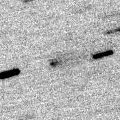
|
Now it is 18.6 mag (Nov. 3, J. L. Virlichie, P. Traverse, H. Roy, G. Houdin). It stays observable at 17 mag until winter. It will become observable in good condition also in the Southern Hemisphere. It is fainter than this ephemeris recently.
Date(TT) R.A. (2000) Decl. Delta r Elong. m1 Best Time(A, h)
Nov. 5 9 35.98 13 7.5 2.193 2.248 80 17.2 4:58 (307, 58)
Nov. 12 9 43.83 11 50.7 2.138 2.277 85 17.2 5:04 (318, 61)
|
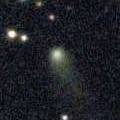
|
Now it is 16.2 mag (Oct. 21, Toshihiko Ikemura, Hirohisa Sato). Fading slowly. In the Southern Hemisphere, it is not observable after this.
Date(TT) R.A. (2000) Decl. Delta r Elong. m1 Best Time(A, h)
Nov. 5 16 25.00 37 37.6 6.096 5.644 58 17.2 18:28 (117, 31)
Nov. 12 16 32.32 37 40.3 6.124 5.673 58 17.3 18:23 (118, 28)
|
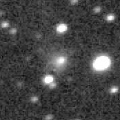
|
Now it is 17.3 mag (Oct. 19, Toshihiko Ikemura, Hirohisa Sato). It stayed bright for a while even after the perihelion passage, but it will be fading after this. It will be fainter than 18 mag in winter.
Date(TT) R.A. (2000) Decl. Delta r Elong. m1 Best Time(A, h)
Nov. 5 21 13.51 -0 48.8 7.094 7.299 98 17.3 18:28 ( 5, 54)
Nov. 12 21 13.26 -1 29.6 7.242 7.326 90 17.3 18:23 ( 15, 53)
|
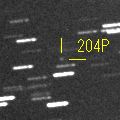
|
Now it is 17.6 mag (Oct. 26, Toshihiko Ikemura, Hirohisa Sato). It will brighten rapidly, and it will be observable at 16 mag in good condition in winter.
Date(TT) R.A. (2000) Decl. Delta r Elong. m1 Best Time(A, h)
Nov. 5 8 56.95 15 58.2 1.545 1.837 90 17.5 4:58 (320, 66)
Nov. 12 9 10.43 15 26.7 1.480 1.835 93 17.3 5:04 (331, 68)
|
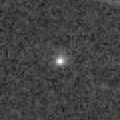
|
Now it is 16.6 mag (Oct. 19, Toshihiko Ikemura, Hirohisa Sato). It stays observable at 17-18 mag until next summer. It may be brighter than this ephemeris.
Date(TT) R.A. (2000) Decl. Delta r Elong. m1 Best Time(A, h)
Nov. 5 22 13.53 -15 11.6 1.453 1.991 107 17.3 19:14 ( 0, 40)
Nov. 12 21 51.27 -14 45.7 1.577 1.944 95 17.4 18:25 ( 0, 40)
|
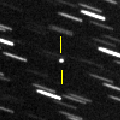
|
It approached to Sun down to 0.14 a.u. on May 15. But it was not observable around that time. In the Northern Hemisphere, it stays observable at 17-18 mag in good condition from July to November. In the Southern Hemisphere, it stays extremely low.
Date(TT) R.A. (2000) Decl. Delta r Elong. m1 Best Time(A, h)
Nov. 5 1 48.95 41 9.4 1.296 2.222 152 17.3 22:49 (180, 84)
Nov. 12 1 31.71 38 43.6 1.336 2.250 150 17.4 22:05 (180, 86)
|
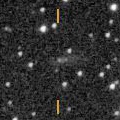
|
Now it is 16.9 mag (Oct. 23, Toshihiko Ikemura, Hirohisa Sato). In the Northern Hemisphere, it stays observable at 17 mag in good condition for a long time until winter. In the Southern Hemisphere, it stays extremely low for a long time.
Date(TT) R.A. (2000) Decl. Delta r Elong. m1 Best Time(A, h)
Nov. 5 8 4.65 48 6.9 2.450 2.902 107 17.4 4:58 (188, 77)
Nov. 12 8 10.57 48 35.2 2.401 2.924 112 17.4 4:48 (180, 76)
|
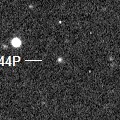
|
Now it is 17.7 mag (Oct. 23, Toshihiko Ikemura, Hirohisa Sato). It is observable at 17 mag in good condition in winter. It locates somewhat low in the Southern Hemisphere.
Date(TT) R.A. (2000) Decl. Delta r Elong. m1 Best Time(A, h)
Nov. 5 6 32.82 25 56.3 3.269 3.921 124 17.5 3:38 ( 0, 81)
Nov. 12 6 31.93 26 1.1 3.188 3.920 132 17.4 3:09 ( 0, 81)
|

|
Now it is 17.2 mag (Oct. 16, ATLAS-MLO, Mauna Loa). It stays observable at 17-18 mag in 2022. It locates somewhat low in the Southern Hemisphere.
Date(TT) R.A. (2000) Decl. Delta r Elong. m1 Best Time(A, h)
Nov. 5 1 4.24 23 43.8 4.656 5.577 156 17.5 22:05 ( 0, 79)
Nov. 12 0 55.77 22 40.4 4.722 5.592 148 17.5 21:29 ( 0, 78)
|

|
Now it is 19.8 mag (Oct. 7, J. L. Virlichie, P. Traverse, H. Roy, G. Houdin). It will approach to Sun down to 0.1 a.u. on Jan. 31. In the Northern Hemisphere, it will appear in the morning sky at 9 mag in mid February, then it stays observable while the comet will be fading. In the Southern Hemisphere, it stays observable for a long time, although it is not observable from mid January to mid February.
Date(TT) R.A. (2000) Decl. Delta r Elong. m1 Best Time(A, h)
Nov. 5 18 0.08 -48 50.7 2.321 1.891 52 17.8 18:28 ( 31, -5)
Nov. 12 18 9.16 -48 12.8 2.297 1.791 47 17.5 18:23 ( 33, -6)
|

|
It brightened up to 12.3 mag from spring to summer in 2021 (June 15, 2021, Marco Goiato). Now it is fading. It will be fainter than 18 mag in January.
Date(TT) R.A. (2000) Decl. Delta r Elong. m1 Best Time(A, h)
Nov. 5 12 37.31 29 33.0 6.526 5.994 53 17.6 4:58 (254, 31)
Nov. 12 12 39.46 30 0.6 6.484 6.040 59 17.6 5:04 (257, 37)
|

|
Now it is 18.2 mag (Oct. 26, Toshihiko Ikemura, Hirohisa Sato). It is observable at 17 mag in excellent condition in winter. It is fainter than this ephemeris recently.
Date(TT) R.A. (2000) Decl. Delta r Elong. m1 Best Time(A, h)
Nov. 5 8 50.14 5 20.6 3.420 3.541 88 17.7 4:58 (333, 58)
Nov. 12 8 54.50 4 31.9 3.317 3.533 94 17.6 5:04 (347, 59)
|
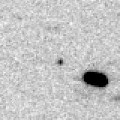
|
Now it is 17.4 mag (Oct. 23, Toshihiko Ikemura, Hirohisa Sato). It stays observable at 16 mag for a long time from early 2023 to early 2024. In the Northern Hemisphere, it is observable only until 2023 spring.
Date(TT) R.A. (2000) Decl. Delta r Elong. m1 Best Time(A, h)
Nov. 5 10 32.85 8 41.7 5.000 4.679 65 17.7 4:58 (296, 45)
Nov. 12 10 33.86 7 41.8 4.852 4.643 72 17.6 5:04 (306, 50)
|
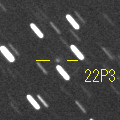
|
Now it is 17.9 mag (Oct. 26, Toshihiko Ikemura, Hirohisa Sato). In the Northern Hemisphere, it is observable at 17-18 mag in excellent condition in autumn. It is not observable in the Southern Hemisphere.
Date(TT) R.A. (2000) Decl. Delta r Elong. m1 Best Time(A, h)
Nov. 5 8 11.99 54 21.8 2.326 2.775 106 17.8 4:58 (188, 70)
Nov. 12 8 19.30 57 20.9 2.291 2.804 111 17.8 4:57 (180, 68)
|
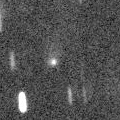
|
Now it is 17.9 mag (Oct. 19, Toshihiko Ikemura, Hirohisa Sato). It started fading before the perihelion passage. It was predicted to stay at 16 mag for a long time. But actually, it will be fainter than 18 mag soon. In the Northern Hemisphere, it stays observable in good condition for a long time. In the Southern Hemisphere, it is not observable until 2023.
Date(TT) R.A. (2000) Decl. Delta r Elong. m1 Best Time(A, h)
Nov. 5 18 10.57 40 47.8 4.266 4.115 74 17.8 18:28 (113, 52)
Nov. 12 18 17.72 38 46.2 4.341 4.140 71 17.9 18:23 (111, 48)
|
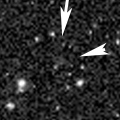
|
Now it is 17.4 mag (Oct. 28, ATLAS Chile). Very far object. It stays 18 mag for a long time from 2021 to 2026. In the Southern Hemisphere, it stays observable in good condition for a long time. In the Northern Hemisphere, it is not observable at all.
Date(TT) R.A. (2000) Decl. Delta r Elong. m1 Best Time(A, h)
Nov. 5 8 13.80 -71 48.1 10.681 10.506 77 17.9 4:58 (358,-17)
Nov. 12 8 8.93 -72 37.5 10.668 10.499 77 17.9 4:45 ( 0,-18)
|
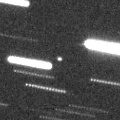
|
Now it is 17.4 mag (Oct. 23, Toshihiko Ikemura, Hirohisa Sato). In 2022, it stays observable at 17 mag for a long time.
Date(TT) R.A. (2000) Decl. Delta r Elong. m1 Best Time(A, h)
Nov. 5 8 24.19 20 8.6 0.787 1.356 98 17.9 4:58 (334, 74)
Nov. 12 8 26.84 19 37.4 0.787 1.415 104 17.9 5:04 ( 0, 75)
|
|
![]()
 P/2022 L3 ( ATLAS )
P/2022 L3 ( ATLAS ) C/2021 T4 ( Lemmon )
C/2021 T4 ( Lemmon ) 22P/Kopff
22P/Kopff 119P/Parker-Hartley
119P/Parker-Hartley 116P/Wild 4
116P/Wild 4 C/2020 Y2 ( ATLAS )
C/2020 Y2 ( ATLAS ) C/2022 U2 ( ATLAS )
C/2022 U2 ( ATLAS ) 61P/Shajn-Schaldach
61P/Shajn-Schaldach C/2021 G2 ( ATLAS )
C/2021 G2 ( ATLAS ) 285P/LINEAR
285P/LINEAR C/2021 S3 ( PanSTARRS )
C/2021 S3 ( PanSTARRS ) 408P/2020 M7 ( Novichonok-Gerke )
408P/2020 M7 ( Novichonok-Gerke ) (65803) Didymos
(65803) Didymos 157P/Tritton
157P/Tritton 77P/Longmore
77P/Longmore 44P/Reinmuth 2
44P/Reinmuth 2 C/2021 C5 ( PanSTARRS )
C/2021 C5 ( PanSTARRS ) C/2020 F5 ( MASTER )
C/2020 F5 ( MASTER ) 395P/2020 H1 ( Catalina-NEAT )
395P/2020 H1 ( Catalina-NEAT ) 327P/Van Ness
327P/Van Ness 9P/Tempel 1
9P/Tempel 1 246P/NEAT
246P/NEAT C/2022 E2 ( ATLAS )
C/2022 E2 ( ATLAS ) P/2021 N2 ( Fuls )
P/2021 N2 ( Fuls ) C/2019 O3 ( Palomar )
C/2019 O3 ( Palomar ) C/2022 S3 ( PanSTARRS )
C/2022 S3 ( PanSTARRS ) C/2019 F1 ( ATLAS-Africano )
C/2019 F1 ( ATLAS-Africano ) C/2022 L2 ( ATLAS )
C/2022 L2 ( ATLAS ) 402P/2020 Q3 ( LINEAR )
402P/2020 Q3 ( LINEAR ) P/2022 P2 ( ZTF )
P/2022 P2 ( ZTF ) C/2020 H6 ( ATLAS )
C/2020 H6 ( ATLAS ) C/2019 T3 ( ATLAS )
C/2019 T3 ( ATLAS ) 204P/LINEAR-NEAT
204P/LINEAR-NEAT C/2022 Q2 ( ATLAS )
C/2022 Q2 ( ATLAS ) (3200) Phaethon
(3200) Phaethon C/2021 QM45 ( PanSTARRS )
C/2021 QM45 ( PanSTARRS ) 244P/Scotti
244P/Scotti C/2020 U4 ( PanSTARRS )
C/2020 U4 ( PanSTARRS ) 96P/Machholz 1
96P/Machholz 1 C/2020 J1 ( SONEAR )
C/2020 J1 ( SONEAR ) P/2021 V2 ( Fuls )
P/2021 V2 ( Fuls ) C/2022 A3 ( Lemmon-ATLAS )
C/2022 A3 ( Lemmon-ATLAS ) C/2022 P3 ( ZTF )
C/2022 P3 ( ZTF ) C/2020 U5 ( PanSTARRS )
C/2020 U5 ( PanSTARRS ) C/2019 E3 ( ATLAS )
C/2019 E3 ( ATLAS ) 107P/(4015) Wilson-Harrington
107P/(4015) Wilson-Harrington![]()


































































